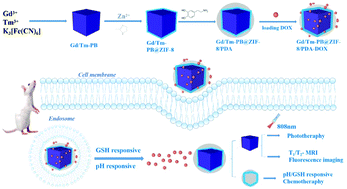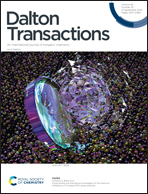Controllable synthesis of rare earth (Gd3+,Tm3+) doped Prussian blue for multimode imaging guided synergistic treatment†
Abstract
Gd3+ and Tm3+ doped Prussian blue (Gd/Tm–PB) with high uniformity and dispersibility was synthesized by a facile solvothermal method. The conditions for the synthesis of Gd/Tm–PB were explored. Through the regulation of the ratio of Gd3+/Tm3+, the Gd/Tm–PB particles with the optimal size (about 150–200 nm) and the best fluorescence and photothermal effect were obtained. On the basis of the optimal Gd/Tm–PB, further coated by polydopamine (PDA) functionalized metal–organic frameworks (MOFs), a multifunctional platform Gd/Tm–PB@ZIF-8/PDA for cancer diagnosis and treatment was established. Doxorubicin (DOX) was selected as a drug model and the drug loading of Gd/Tm–PB@ZIF-8/PDA was found to be 81 mg g−1. Cytotoxicity analysis indicated that Gd/Tm–PB@ZIF-8/PDA was highly biocompatible. The DOX release at different pH values and GSH concentrations revealed an excellent pH/GSH-triggered drug release. Through the combination of the near infrared photothermal performance of Gd/Tm–PB, chemo-photothermal therapy can be achieved to further improve the anti-cancer efficiency. In addition, the Gd/Tm–PB@ZIF-8/PDA nanoparticles can be tracked by fluorescence imaging (FOI) and magnetic resonance imaging (MRI). Cell FOI and in vivo MRI experiments showed the potential application of Gd/Tm–PB@ZIF-8/PDA in dual mode imaging guided therapy. In vivo antitumor experiments demonstrated the higher anticancer efficacy of Gd/Tm–PB@ZIF-8/PDA with a combined effect of chemo-photothermal therapy. This work provides a new strategy for nano-drug carriers in the direction of integrated diagnosis and treatment.



 Please wait while we load your content...
Please wait while we load your content...